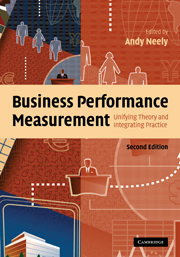Book contents
- Frontmatter
- Contents
- List of figures
- List of tables
- List of boxes
- List of contributors
- Introduction
- Part I Performance measurement – functional analyses and theoretical foundations
- 1 Accounting performance measurement: a review of its purposes and practices
- 2 Measuring marketing performance: research, practice and challenges
- 3 Measuring performance: the operations management perspective
- 4 Measuring performance: the supply chain management perspective
- 5 Finding performance: the new discipline in management
- 6 A conceptual and operational delineation of performance
- Part II Performance measurement – frameworks and methodologies
- Part III Performance measurement – practicalities and challenges
- Part IV Performance measurement in public services
- Part V Performance measurement – emerging issues and enduring questions
- Index
- References
3 - Measuring performance: the operations management perspective
Published online by Cambridge University Press: 22 September 2009
- Frontmatter
- Contents
- List of figures
- List of tables
- List of boxes
- List of contributors
- Introduction
- Part I Performance measurement – functional analyses and theoretical foundations
- 1 Accounting performance measurement: a review of its purposes and practices
- 2 Measuring marketing performance: research, practice and challenges
- 3 Measuring performance: the operations management perspective
- 4 Measuring performance: the supply chain management perspective
- 5 Finding performance: the new discipline in management
- 6 A conceptual and operational delineation of performance
- Part II Performance measurement – frameworks and methodologies
- Part III Performance measurement – practicalities and challenges
- Part IV Performance measurement in public services
- Part V Performance measurement – emerging issues and enduring questions
- Index
- References
Summary
Introduction
This chapter explores performance measurement from an operations perspective. Members of the operations management community have been interested in performance measurement – at both the strategic and the tactical level – for decades. Wickham Skinner, widely credited with the development of the operations strategy framework, for example, observed in 1974:
A factory cannot perform well on every yardstick. There are a number of common standards for measuring manufacturing performance. Among these are short delivery cycles, superior product quality and reliability, dependable delivery promises, ability to produce new products quickly, flexibility in adjusting to volume changes, low investment and hence higher return on investment, and low costs.
These measures of manufacturing performance necessitate trade-offs – certain tasks must be compromised to meet others. They cannot all be accomplished equally well because of the inevitable limitations of equipment and process technology. Such trade-offs as costs versus quality or short delivery cycles versus low inventory investment are fairly obvious. Other trade-offs, while less obvious, are equally real. They involve implicit choices in establishing manufacturing policies.
(Skinner, 1974, 115)Skinner's early work on operations (initially manufacturing) strategy influenced a generation of researchers, all of whom subsequently explored the question of how to align operations policies with operations objectives (see, for example, Hayes and Wheelwright, 1984; Hayes, Wheelwright and Clark, 1988; Hill, 1985; Mills, Platts and Gregory, 1995; Platts and Gregory, 1990; Slack and Lewis, 2001).
It was during this phase of exploration that the operations management community's interest in performance measurement was probably at its peak, with numerous authors asking how organizational performance measurement systems could be aligned with operations strategies (for a comprehensive review of these works, see Neely, Gregory and Platts, 1995).
Information
- Type
- Chapter
- Information
- Business Performance MeasurementUnifying Theory and Integrating Practice, pp. 64 - 81Publisher: Cambridge University PressPrint publication year: 2007
References
Accessibility standard: Unknown
Why this information is here
This section outlines the accessibility features of this content - including support for screen readers, full keyboard navigation and high-contrast display options. This may not be relevant for you.Accessibility Information
- 13
- Cited by
